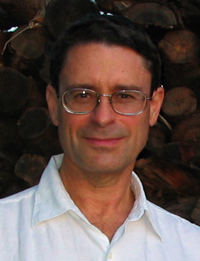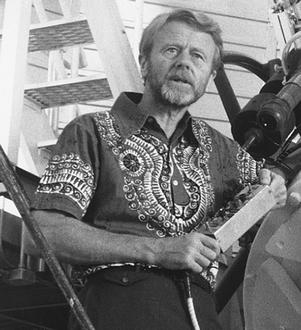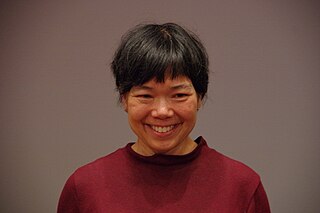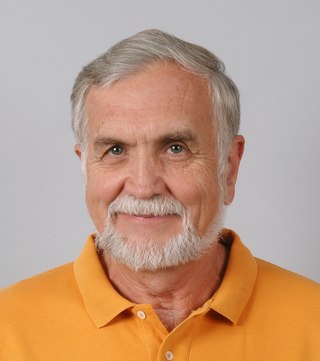Related Research Articles

2060 Chiron is a small Solar System body in the outer Solar System, orbiting the Sun between Saturn and Uranus. Discovered in 1977 by Charles Kowal, it was the first-identified member of a new class of objects now known as centaurs—bodies orbiting between the asteroid belt and the Kuiper belt.
George Ogden Abell was an American educator. Teaching at UCLA, priorly he worked as a research astronomer, administrator, as a popularizer of science and of education, and as a skeptic. He earned his B.S. in 1951, his M.S. in 1952 and his Ph.D. in 1957, all from the California Institute of Technology. He was a Ph.D. student under Donald Osterbrock. His astronomical career began as a tour guide at the Griffith Observatory in Los Angeles. Abell made great contributions to astronomical knowledge which resulted from his work during and after the National Geographic Society - Palomar Observatory Sky Survey, especially concerning clusters of galaxies and planetary nebulae. A galaxy, an asteroid, a periodic comet, and an observatory are all named in his honor. His teaching career extended beyond the campus of UCLA to the high school student oriented Summer Science Program, and educational television. He not only taught about science but also about what is not science. He was an originating member of the Committee on Scientific Investigation of Claims of the Paranormal now known as the Committee for Skeptical Inquiry.

Eugene Merle Shoemaker was an American geologist. He co-discovered Comet Shoemaker–Levy 9 with his wife Carolyn S. Shoemaker and David H. Levy. This comet hit Jupiter in July 1994: the impact was televised around the world. Shoemaker also studied terrestrial craters, such as Barringer Meteor Crater in Arizona, and along with Edward Chao provided the first conclusive evidence of its origin as an impact crater. He was also the first director of the United States Geological Survey's Astrogeology Research Program.

Steven Jeffrey Ostro was an American scientist specializing in radar astronomy. He worked at NASA's Jet Propulsion Laboratory. Ostro led radar observations of numerous asteroids, as well as the moons of Jupiter and Saturn, Saturn's rings, and Mars and its satellites. As of May 2008, Ostro and his collaborators had detected 222 near-Earth asteroids and 118 main belt objects with radar.
Schelte John "Bobby" Bus is an American astronomer and discoverer of minor planets at the Institute for Astronomy of the University of Hawaii and deputy director of NASA's Infrared Telescope Facility (IRTF) at the Mauna Kea Observatory in Hawaii, United States.

Anton M.J. "Tom" Gehrels was a Dutch–American astronomer, Professor of Planetary Sciences, and Astronomer at the University of Arizona, Tucson.
The Center for Planetary Research at the University of Copenhagen was created in February 2001 when the planetary science groups from the Niels Bohr Institute and the Danish Space Research Institute (DSRI) [Danish: Dansk Rumforskningsinstitut, short DRI or DRKI] were merged. It no longer existed in August 2011. Together with associated national and international groups it aimed to strengthen planetary research in Denmark and to provide a platform for the education of planetary researchers. It spanned a broad range of disciplines from astronomy, physics, geophysics, and space instrumentation to geology and biology.

David Clifford Jewitt is a British-American astronomer who studies the Solar System, especially its minor bodies. He is based at the University of California, Los Angeles, where he is a Member of the Institute for Geophysics and Planetary Physics, the Director of the Institute for Planets and Exoplanets, Professor of Astronomy in the Department of Physics and Astronomy and Professor of Astronomy in the Department of Earth, Planetary and Space Sciences. He is best known for being the first person to discover a body beyond Pluto and Charon in the Kuiper belt.

Jane X. Luu is a Vietnamese-American astronomer and defense systems engineer. She was awarded the Kavli Prize for 2012 "for discovering and characterizing the Kuiper Belt and its largest members, work that led to a major advance in the understanding of the history of our planetary system".
The Lunar and Planetary Institute (LPI) is a scientific research institute dedicated to study of the solar system, its formation, evolution, and current state. The Institute is part of the Universities Space Research Association (USRA) and is supported by the Science Mission Directorate of the National Aeronautics and Space Administration (NASA). Located at 3600 Bay Area Boulevard in Houston, Texas, the LPI maintains an extensive collection of lunar and planetary data, carries out education and public outreach programs, and offers meeting coordination and publishing services. The LPI sponsors and organizes several workshops and conferences throughout the year, including the Lunar and Planetary Science Conference (LPSC) held in March in the Houston area.

Brian Todd O'Leary was an American scientist, author, and NASA astronaut. He was part of NASA Astronaut Group 6, a group of scientist-astronauts chosen with the intention of training for the Apollo Applications Program.

Maria T. Zuber is an American geophysicist who is the vice president for research at the Massachusetts Institute of Technology, where she also holds the position of the E. A. Griswold Professor of Geophysics in the Department of Earth, Atmospheric and Planetary Sciences. Zuber has been involved in more than half a dozen NASA planetary missions aimed at mapping the Moon, Mars, Mercury, and several asteroids. She was the principal investigator for the Gravity Recovery and Interior Laboratory (GRAIL) Mission, which was managed by NASA's Jet Propulsion Laboratory.

James F. Bell III is a professor of Astronomy at Arizona State University, specializing in the study of planetary geology, geochemistry and mineralogy using data obtained from telescopes and from various spacecraft missions. Bell's active research has involved the NASA Mars Pathfinder, Near Earth Asteroid Rendezvous (NEAR), Comet Nucleus Tour (CONTOUR), 2001 Mars Odyssey, Mars Reconnaissance Orbiter, Lunar Reconnaissance Orbiter, and the Mars Science Laboratory missions. His book Postcards from Mars includes many images taken by the Mars rovers. Bell is currently an editor of the space science journal Icarus and president of The Planetary Society. He has served as the lead scientist in charge of the Panoramic camera (Pancam) color imaging system on Mars rovers Spirit and Opportunity.
Jon Lomberg is an American space artist and science journalist. He was Carl Sagan's principal artistic collaborator for more than twenty years on many projects from 1972 through 1996. In 1998, the International Astronomical Union officially named an asteroid in recognition of his achievements in science communication. He was NASA's Design Director for the Golden Record on the Voyager spacecraft; the cover he designed is expected to last at least a billion years.
Peter H. Schultz is Professor of Geological Sciences at Brown University specializing in the study of planetary geology, impact cratering on the Earth and other objects in the Solar System, and volcanic modifications of planetary surfaces. He was co-investigator to the NASA Science Mission Directorate spacecraft Deep Impact and the Lunar Crater Observation and Sensing Satellite (LCROSS). He was awarded the Barringer Medal of the Meteoritical Society in 2004 for his theoretical and experimental studies of impact craters.

David Morrison is an American astronomer, a senior scientist at the Solar System Exploration Research Virtual Institute, at NASA Ames Research Center in Mountain View, California. Morrison is the former director of the Carl Sagan Center for Study of Life in the Universe at the SETI Institute and of the NASA Lunar Science Institute. He is the past Director of Space at NASA Ames. Morrison is credited as a founder of the multi-disciplinary field of astrobiology. Morrison is best known for his work in risk assessment of near Earth objects such as asteroids and comets. Asteroid 2410 Morrison was named in his honor. Morrison is also known for his "Ask an Astrobiologist" series on NASA's website where he provides answers to questions submitted by the public. He has published 12 books and over 150 papers primarily on planetary science, astrobiology and near Earth objects.

Ronald Greeley was a Regents’ Professor in the School of Earth and Space Exploration (SESE) at Arizona State University (ASU), the Director of the NASA-ASU Regional Planetary Image Facility (RPIF), and Principal Investigator of the Planetary Aeolian Laboratory at NASA-Ames Research Center. He was involved with lunar and planetary studies since 1967 and most recently focused his research on understanding planetary surface processes and geologic histories.

Planetary science is the scientific study of planets, celestial bodies and planetary systems and the processes of their formation. It studies objects ranging in size from micrometeoroids to gas giants, aiming to determine their composition, dynamics, formation, interrelations and history. It is a strongly interdisciplinary field, which originally grew from astronomy and Earth science, and now incorporates many disciplines, including planetary geology, cosmochemistry, atmospheric science, physics, oceanography, hydrology, theoretical planetary science, glaciology, and exoplanetology. Allied disciplines include space physics, when concerned with the effects of the Sun on the bodies of the Solar System, and astrobiology.

Lindy Elkins-Tanton is a planetary scientist and professor; her research concerns terrestrial planetary evolution. She is the Principal Investigator of NASA's Psyche mission to explore the metallic asteroid 16 Psyche, Arizona State University Vice President of the Interplanetary Initiative, and co-founder of Beagle Learning, a tech company training and measuring collaborative problem-solving and critical thinking.

Lucy-Ann Adams McFadden is an American astronomer and planetary scientist. An employee of NASA, she also founded the Science, Discovery & the Universe Program within the University of Maryland, and the Explore-It-All Science Center, a children's science program.
References
- ↑ American Men & Women of Science, Volume 3. Thomson/Gale. 2009. ISBN 9780787665234 . Retrieved 1 December 2017.
- ↑ "Michael J Gaffey, Ph D". University of North Dakota. Retrieved 1 December 2017.
- ↑ 03/30/06 UND’s Mike Gaffey Earns Two Top Space Science Awards: Like Getting Oscar, Golden Globe In One Year; Gala Celebration Is April 7 Archived 2010-06-25 at the Wayback Machine retrieved 19 December 2009
- ↑ "(3545) Gaffey". Minor Planet Center. Retrieved 1 December 2017.